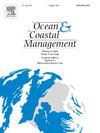Behavioral responses of whale sharks to fishing intensity Reduction: Implications for fishery management and megafauna conservation
IF 5.4
2区 环境科学与生态学
Q1 OCEANOGRAPHY
引用次数: 0
Abstract
Understanding how marine megafauna respond to human activity changes is challenging but essential for effective conservation and management. Using China's summer fishing moratoria and the COVID-19 lockdown as quasi-natural experiments, we aimed to investigate whether temporal reductions in fishing activity affect the occurrence of whale sharks (Rhincodon typus) in Chinese coastal seas. We compiled occurrence records from social media platforms (2016–2023), standardized them by fishing effort data derived from Global Fishing Watch, and validated findings through interviews with local fishers. Our analysis revealed that both the summer moratoria and the COVID-19 lockdown significantly reduced fishing intensity, with moratoria having a stronger effect. Standardized whale shark occurrences increased significantly during summer moratoria, suggesting behavioral return to coastal foraging grounds in response to predictable, high-magnitude reductions in human disturbance. However, no comparable effect was detected during the COVID-19 lockdown. These findings highlight the role of disturbance magnitude and temporal predictability in shaping marine megafauna behavior. Additionally, the occurrences from social media also renewed the IUCN range map and suggested some foraging sites of whale sharks in China's seas. We recommend targeted protection at seasonal foraging sites during summer moratoria and adaptive spatial management to mitigate bycatch risks in China's seas. Our study highlights the utility of integrating social-media sightings and local ecological knowledge to assess the behavioral response of marine megafauna to policy interventions, and to monitor spatio-temporal dynamics of rare and iconic marine megafauna at large spatial extents.
鲸鲨对捕捞强度降低的行为反应:对渔业管理和大型动物保护的影响
了解海洋巨型动物如何应对人类活动的变化是具有挑战性的,但对有效的保护和管理至关重要。利用中国夏季休渔期和新冠肺炎疫情防控作为准自然实验,我们旨在调查捕捞活动的暂时减少是否会影响中国沿海海域鲸鲨(Rhincodon typus)的发生。我们收集了社交媒体平台(2016-2023年)的发生记录,通过全球渔业观察(Global fishing Watch)的捕捞努力量数据对其进行了标准化,并通过对当地渔民的采访验证了调查结果。我们的分析显示,夏季暂停捕捞和COVID-19封锁都显著降低了捕捞强度,暂停捕捞的效果更强。在夏季暂停期间,标准化鲸鲨的数量显著增加,这表明,人类干扰的可预测的大幅减少表明,鲸鲨的行为回归到沿海觅食地。然而,在COVID-19封锁期间没有发现类似的效果。这些发现强调了干扰程度和时间可预测性在塑造海洋巨型动物行为中的作用。此外,社交媒体上的事件也更新了世界自然保护联盟的范围地图,并提出了中国海域鲸鲨的一些觅食地点。我们建议在夏季暂停期间对季节性觅食地点进行有针对性的保护,并进行适应性空间管理,以减轻中国海域的副渔获风险。我们的研究强调了整合社交媒体目击和当地生态知识的效用,以评估海洋巨型动物对政策干预的行为反应,并在大空间范围内监测稀有和标志性海洋巨型动物的时空动态。
本文章由计算机程序翻译,如有差异,请以英文原文为准。
求助全文
约1分钟内获得全文
求助全文
来源期刊

Ocean & Coastal Management
环境科学-海洋学
CiteScore
8.50
自引率
15.20%
发文量
321
审稿时长
60 days
期刊介绍:
Ocean & Coastal Management is the leading international journal dedicated to the study of all aspects of ocean and coastal management from the global to local levels.
We publish rigorously peer-reviewed manuscripts from all disciplines, and inter-/trans-disciplinary and co-designed research, but all submissions must make clear the relevance to management and/or governance issues relevant to the sustainable development and conservation of oceans and coasts.
Comparative studies (from sub-national to trans-national cases, and other management / policy arenas) are encouraged, as are studies that critically assess current management practices and governance approaches. Submissions involving robust analysis, development of theory, and improvement of management practice are especially welcome.
 求助内容:
求助内容: 应助结果提醒方式:
应助结果提醒方式:


